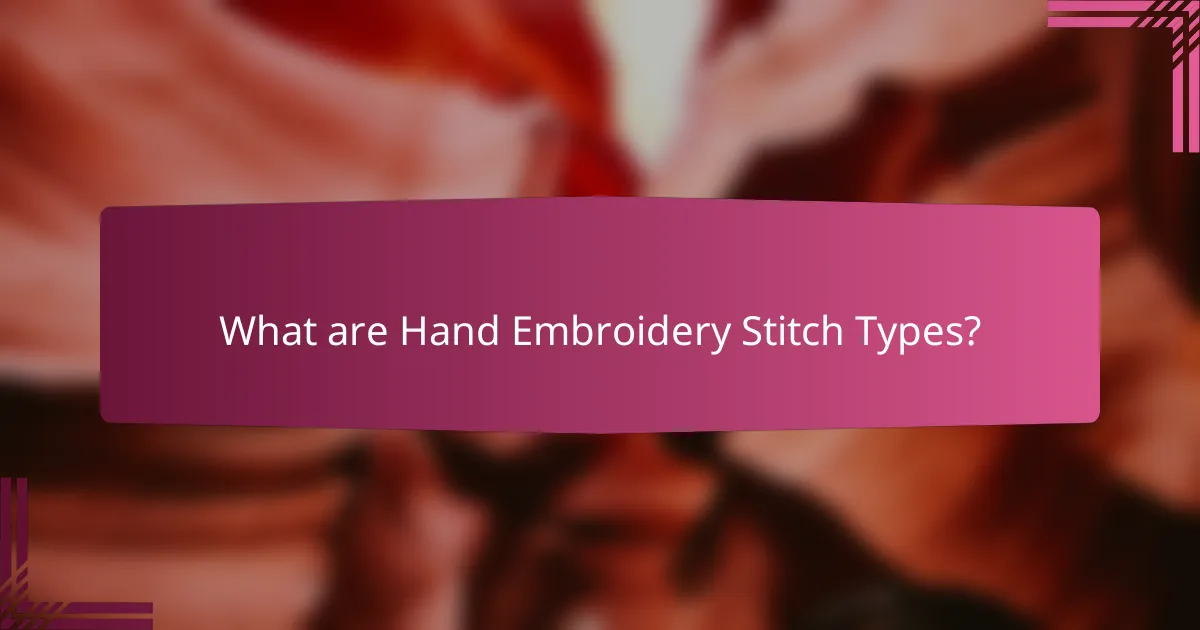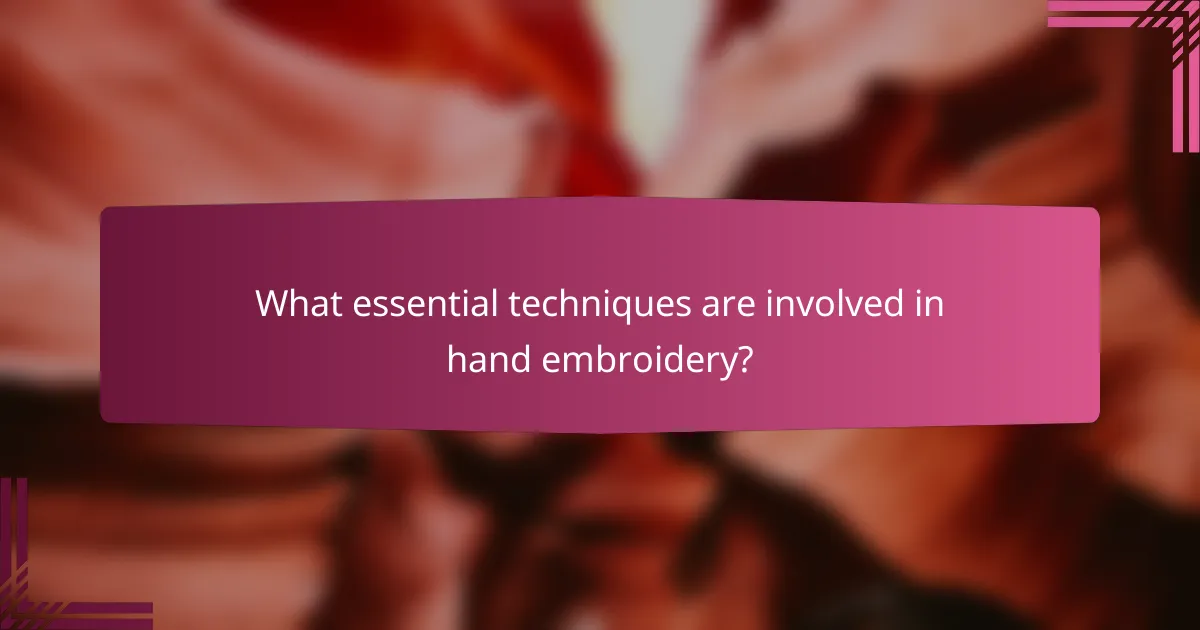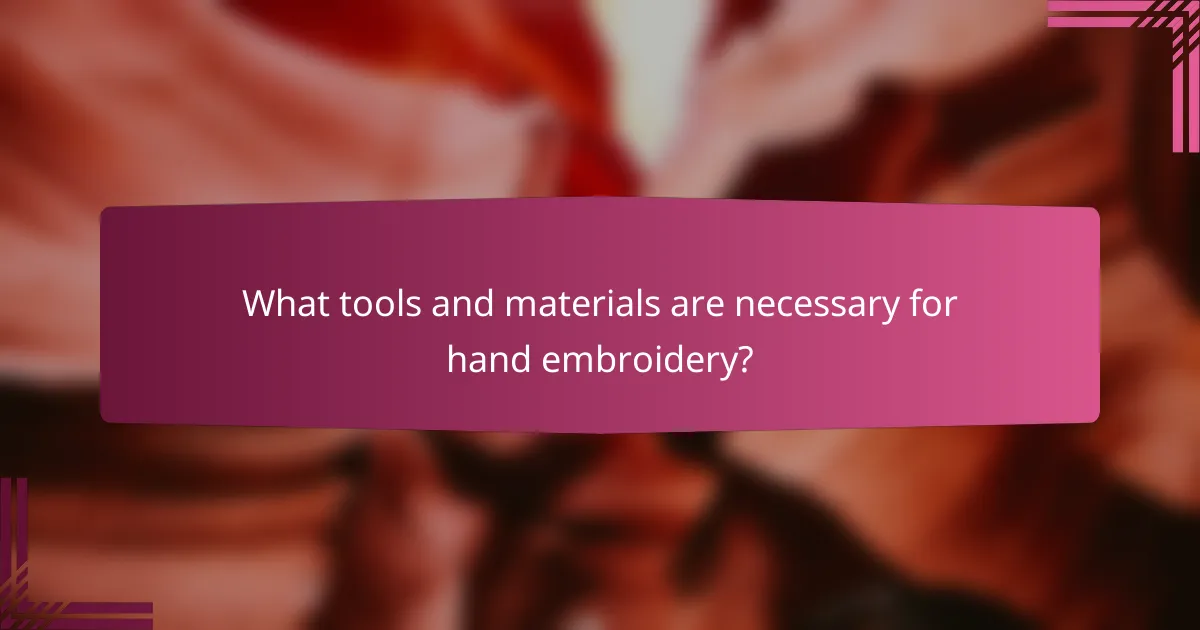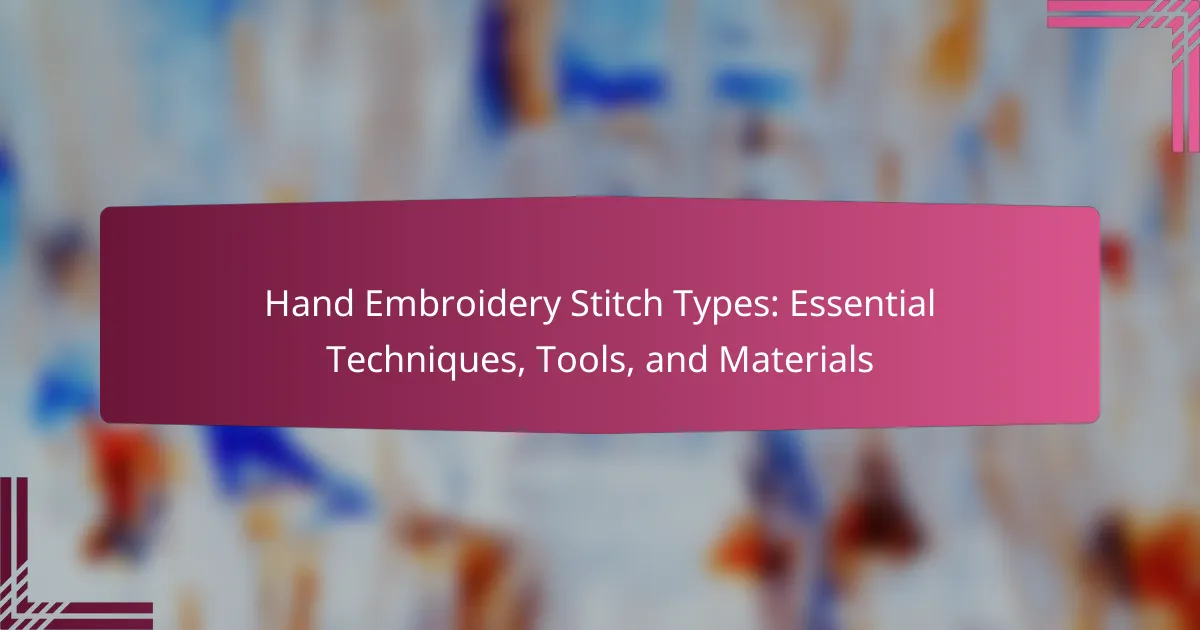
What are Hand Embroidery Stitch Types?
Hand embroidery stitch types include various techniques used to create designs on fabric. Common stitch types are the straight stitch, backstitch, satin stitch, and French knot. The straight stitch is a basic stitch used for outlining. The backstitch creates a solid line and is often used for lettering. The satin stitch fills shapes with color and texture. The French knot adds dimension and is often used for floral designs. Each stitch type serves a unique purpose in embroidery, allowing for creativity and detail in projects.
How do different stitch types enhance hand embroidery?
Different stitch types enhance hand embroidery by providing texture, depth, and visual interest. Each stitch type serves a unique purpose and can alter the final appearance of the work. For instance, satin stitch creates a smooth, shiny surface, ideal for filling shapes. Conversely, backstitch offers defined outlines, enhancing detail and structure. French knots add dimension and a playful touch to designs. Furthermore, varying stitch lengths can create shading effects, adding realism to embroidered images. Ultimately, the choice of stitch type can transform a simple design into a complex and captivating piece of art.
What are the basic characteristics of popular stitch types?
Popular stitch types have distinct characteristics that define their use and appearance. The straight stitch is simple and versatile, often used for outlining and detailing. The backstitch creates a solid line, providing strength and durability in seams. The satin stitch fills shapes with a smooth, glossy finish, ideal for solid areas. The French knot adds texture and dimension, commonly used for decorative accents. The chain stitch forms a series of connected loops, useful for borders and outlines. Each stitch type serves specific purposes in hand embroidery, enhancing creativity and technique.
How do stitch types differ in their applications?
Stitch types differ in their applications based on their structure and function. For example, straight stitches are commonly used for outlining and creating fine details. Satin stitches provide a smooth finish and are ideal for filling shapes. Chain stitches offer flexibility and are often used for decorative borders. Cross stitches create a textured appearance, making them suitable for patterns. Each stitch type serves a specific purpose in hand embroidery. Their unique characteristics influence their effectiveness in various projects. Understanding these differences helps embroiderers choose the right stitch for their desired outcome.
Why is understanding stitch types important for embroidery enthusiasts?
Understanding stitch types is crucial for embroidery enthusiasts because it directly impacts the quality and style of their work. Different stitch types serve specific purposes and create various textures and effects. For example, a satin stitch provides a smooth finish, while a backstitch offers durability and definition. Knowledge of stitch types allows enthusiasts to select the appropriate technique for their projects. This selection enhances the overall aesthetic and functionality of the embroidery. Mastery of stitch types also enables the creation of intricate designs and patterns. Additionally, understanding the mechanics of each stitch can prevent common errors and improve efficiency. Ultimately, proficiency in stitch types contributes to the skill development of embroidery enthusiasts.
How can mastering stitch types improve your embroidery skills?
Mastering stitch types significantly enhances your embroidery skills. It allows for greater creativity and versatility in design. Different stitches create varied textures and visual effects. This knowledge enables you to choose the right stitch for each project. Mastery of stitches improves precision and technique. It leads to cleaner, more professional-looking work. Studies show that skilled stitchers produce higher quality embroidery. Therefore, understanding stitch types is essential for skill advancement in embroidery.
What role do stitch types play in the overall design of a project?
Stitch types are crucial to the overall design of a project. They determine the texture, appearance, and durability of the finished piece. Different stitch types create varying visual effects, influencing the aesthetic appeal. For example, satin stitches provide a smooth finish, while French knots add dimension. The choice of stitch also affects the fabric’s drape and flexibility. Additionally, specific stitches can enhance the thematic elements of the design. Using a variety of stitches can create contrast and interest in the work. Overall, stitch types significantly shape the visual narrative and craftsmanship of the embroidery project.

What essential techniques are involved in hand embroidery?
Essential techniques involved in hand embroidery include basic stitches, pattern transfer, and fabric preparation. Basic stitches are foundational to creating designs. Examples of basic stitches are running stitch, backstitch, and satin stitch. Pattern transfer involves transferring designs onto fabric using methods like tracing or using transfer paper. Fabric preparation includes selecting appropriate fabric and stabilizers for the project. Proper thread selection is also crucial for achieving desired effects. Techniques like hooping the fabric ensure it remains taut during stitching. Each of these techniques contributes to the overall quality and appearance of the finished embroidery.
How can you effectively learn hand embroidery techniques?
To effectively learn hand embroidery techniques, start with basic stitches. Familiarize yourself with fundamental stitches like the running stitch, backstitch, and satin stitch. Utilize online tutorials and instructional videos for visual guidance. Practice regularly to build muscle memory and confidence. Invest in quality materials, such as fabric and embroidery floss. Joining local embroidery groups can provide support and feedback. Consider taking classes for structured learning. Resources like books and online courses can deepen your understanding. Consistent practice and seeking feedback are key to mastering hand embroidery techniques.
What are the best practices for practicing different stitch types?
To practice different stitch types effectively, begin by selecting a variety of threads and fabrics. Use a fabric that is suitable for embroidery, such as cotton or linen. Start with basic stitches like the straight stitch and gradually move to more complex ones. Maintain consistent tension on the thread to ensure even stitches. Practice on a sample piece before working on your final project. Utilize a hoop to keep the fabric taut while stitching. Refer to instructional videos or guides for visual demonstrations of each stitch. Regular practice will enhance your skill and confidence in using various stitch types.
How do techniques vary based on the type of stitch used?
Techniques vary significantly based on the type of stitch used in hand embroidery. Each stitch type has its own application and method. For example, a straight stitch is often used for outlining and basic filling. It requires a simple up-and-down motion through the fabric. In contrast, a satin stitch creates a smooth, filled area by layering stitches closely together. This technique demands precision in placement for an even finish.
Similarly, a French knot involves wrapping the thread around the needle before pulling it through the fabric. This creates a textured, raised element. Techniques for creating this knot differ from those used in flat stitches. Additionally, a chain stitch forms a series of loops, which can be used for decorative borders. Each stitch type influences the overall texture and appearance of the embroidery.
The choice of stitch affects not only the technique but also the tools and materials needed. For instance, thicker threads may be used for certain stitches to achieve a bolder effect. Understanding these differences is essential for achieving desired results in hand embroidery.
What common challenges do beginners face in mastering these techniques?
Beginners in hand embroidery face several common challenges. One major challenge is mastering the various stitch types. Each stitch requires different techniques and levels of precision. Another challenge is tension control. Maintaining consistent tension is crucial for even stitches. Additionally, beginners often struggle with choosing the right materials. Selecting appropriate fabrics and threads can affect the final outcome. A lack of experience with tools also poses difficulties. Familiarity with needles, hoops, and scissors is essential for effective stitching. Lastly, beginners may have trouble visualizing their designs. Planning and transferring patterns onto fabric can be complex without practice.
How can you troubleshoot issues with stitch execution?
To troubleshoot issues with stitch execution, first, identify the problem. Common issues include uneven tension, thread breaks, and incorrect stitch placement. Check the tension settings on your embroidery machine or adjust your hand tension for better control. Inspect the thread for fraying or knots, which can cause breaks during stitching. Ensure the fabric is properly hooped and not too loose, as this can lead to misalignment. If stitches are skipping, verify the needle type and size match the thread and fabric. Regularly clean the machine to prevent lint buildup, which can affect performance. Lastly, refer to the machine’s manual for specific troubleshooting steps related to stitch execution.
What tips can help improve technique consistency?
Practice regularly to improve technique consistency in hand embroidery. Consistent practice helps reinforce muscle memory. Use a reliable pattern as a guide to maintain accuracy. Keeping your workspace organized minimizes distractions and errors. Choose high-quality materials to ensure better results and consistency. Focus on one stitch at a time to master its technique before moving on. Take breaks to avoid fatigue, which can lead to mistakes. Lastly, seek feedback from experienced embroiderers to identify areas for improvement.

What tools and materials are necessary for hand embroidery?
The tools and materials necessary for hand embroidery include embroidery floss, needles, fabric, and hoops. Embroidery floss is typically made of six strands of cotton or silk. Needles used in hand embroidery are usually sharp and have a larger eye for threading. Fabric choices can range from cotton to linen, depending on the project. Embroidery hoops hold the fabric taut while stitching. Scissors are also essential for trimming threads. Marking tools help in transferring designs onto the fabric. These items are fundamental for executing various hand embroidery techniques effectively.
What basic tools should every hand embroiderer have?
Every hand embroiderer should have a needle, embroidery thread, fabric, scissors, and an embroidery hoop. Needles are essential for stitching through fabric. Embroidery thread comes in various colors and types for different effects. Fabric serves as the base for the embroidery design. Scissors are necessary for cutting thread and fabric cleanly. An embroidery hoop holds the fabric taut, making it easier to stitch. These tools are fundamental for successful hand embroidery projects.
How do different tools affect the quality of stitching?
Different tools significantly affect the quality of stitching. Quality embroidery scissors ensure precise cutting, which prevents fraying. A well-designed needle penetrates fabric smoothly, reducing snagging and distortion. The right thread, such as high-quality cotton, contributes to durability and finish. An ergonomic hoop stabilizes fabric, allowing for consistent tension and even stitches. Tools like marking pens help achieve accurate designs, enhancing overall stitch quality. Each tool’s material and design influence the ease of use and final appearance of the embroidery.
What are the essential materials needed for various stitch types?
Essential materials for various stitch types in hand embroidery include embroidery floss, needles, and fabric. Embroidery floss comes in multiple strands and colors, suitable for different stitches. Needles vary in size and type, such as embroidery or tapestry needles, to accommodate various thread thicknesses and fabric types. Fabric choices include cotton, linen, and canvas, each providing a different texture and weight for stitching. Additionally, scissors, hoops, and stabilizers may be used to enhance the stitching process. These materials collectively enable a range of stitch techniques and ensure successful embroidery projects.
How do you choose the right materials for your embroidery project?
To choose the right materials for your embroidery project, consider the fabric type, thread selection, and needle compatibility. Fabrics like cotton and linen are popular for their durability and ease of use. Choose threads that match your fabric; cotton threads are versatile, while silk offers a luxurious finish. Ensure your needle size corresponds to the thread and fabric; a larger needle is needed for thicker threads. Additionally, consider any embellishments or stabilizers required for the project. Selecting appropriate materials enhances the overall quality and appearance of the embroidery.
What factors should be considered when selecting fabric and thread?
When selecting fabric and thread, consider the fabric type, thread weight, and color compatibility. Different fabrics, such as cotton, linen, or silk, have unique textures and weights that affect the embroidery outcome. Thread weight, indicated by numbers, influences the thickness and coverage of stitches. Choose a thread that complements the fabric’s texture and weight for optimal results. Color compatibility ensures that the thread stands out against the fabric or blends harmoniously, depending on the desired effect. Additionally, consider the fabric’s durability and how it will hold the stitches over time. The right combination of fabric and thread enhances the overall quality of the embroidery project.
How do material choices impact the final outcome of your work?
Material choices significantly impact the final outcome of hand embroidery work. The type of fabric affects the stitch definition and overall appearance. For example, tightly woven fabrics like cotton provide crisp stitches. In contrast, loosely woven fabrics may lead to uneven stitching. Thread type also plays a crucial role. High-quality threads enhance color vibrancy and durability. Conversely, inferior threads can fray and diminish the design’s quality. Additionally, the choice of needles influences the stitching process. A suitable needle ensures smooth application and prevents fabric damage. Overall, selecting appropriate materials directly influences the aesthetics and longevity of the embroidery piece.
What are some best practices for maintaining your embroidery tools and materials?
To maintain your embroidery tools and materials, regularly clean and organize them. Use a soft cloth to wipe down tools after each use. Store needles in a magnetic holder to prevent loss and rust. Keep threads in a cool, dry place to avoid tangling and fading. Regularly inspect fabrics for wear and tear, replacing them as needed. Use proper storage containers to protect materials from dust and moisture. Finally, ensure scissors are sharpened to maintain cutting efficiency. These practices help extend the lifespan of your embroidery tools and materials.
Hand embroidery stitch types encompass various techniques used to create designs on fabric, including straight stitch, backstitch, satin stitch, and French knot. Each stitch type serves a unique purpose, enhancing the texture, depth, and visual interest of embroidery projects. The article covers essential techniques, tools, and materials necessary for effective hand embroidery, as well as best practices for maintaining tools and troubleshooting common challenges faced by beginners. Understanding these elements is crucial for embroidery enthusiasts to improve their skills and achieve desired outcomes in their projects.
